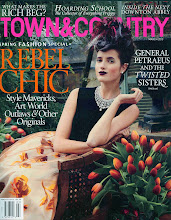Oh, the drama! The client decorator relationship can be fraught with bizarre requests, and insatiable appetite for perfection and other dilemmas. Last week I attended a terrific lecture at the New York School of Interior Design. Mitchell Owens, author and editor at large for Elle Decor, spoke on Pauline de Rothschild's Albany House residence, decorated by John Fowler. Owens has become a treasure trove of great stories from researching de Rothschild for an upcoming book. Fowler came out of retirement in 1972 to work on her London apartment. Perhaps he had moments of regret, as she was fussy and hard to please. She was unique in her dedication and at 75 she began this project, with a zeal for perfection. Decision making could take forever--- a muslin covered chair would sit in a room for months, and would only get upholstered when she felt the selection was perfect (such is the case with the klismos chair in her drawing room shown below). De Rothschild loved to be on her own, and this residence was meant for her sole enjoyment, while her husband resided elsewhere. Hers was a fantasy world for the unconventional, idiosyncratic way she lived.

De Rothschild was a Romantic. She was known to have her clothes made to look like something out of Byron, and she requested the lighting in her home come only from candlestick lamps, as if the rooms were lit by candlelight. She loved Irises and would place them in little vases around the room at a low level, to make her feel as though she was walking through a garden. In her room shown above, painted Chinoiserie wallpaper created a garden-like sanctuary. She loved very low pieces of furniture and the mirror on a stand was placed on the floor so as she passed it looked like she was walking through the flowers. This iconic photo of the Baroness is loved for many reasons. The mass of Chinoiserie paper creates a soothing escape, and when the door is closed it becomes a private garden in the round.

The interiors at The Albany, Fowler was instructed, were to capture the spirit of Tsarist Russia. After a trip there with her second husband, she loved the romantic idea of a hard winter. The long and narrow drawing room captures this fantasy. She wanted the furniture arranged so that each visitor had to walk around all the pieces to get to the settee in the back. They would then take the time to look at the individual items. Mongolian goatskin rugs cover the floor, and a mix of Chinoiserie pieces, a redone 12-foot sofa and Egyptian chairs make up the arrangements. The settee is placed under the window, making it the focal point of the room. Fowler had his workroom upholster the settee in 3 colors of silk creating a broad stripe flanked by two smaller ones. When de Rothschild saw it, she said that was exactly what she wanted! Fowler was horrified but agreed to it, and the result is shown above. Light blue, oyster and soft green silk was used throughout and the silk curtains were their own unique project that were never fully completed. The valance was cut to look like icicles from a hard Russian winter. Another romantic touch, it had bows sewn on the leading edge so that when they closed, they looked tied together. When it came to the wall treatments, Fowler believed that decorative painting should not look exactly like what it was emulating, so the "marble" pilasters look faux for that reason. The chair in the foreground was never upholstered, but tolerated as it was, remaining a constant work in progress.
Fowler referred to his client as "Dear Miss B", and the B did not stand for Baroness.

De Rothschild was a Romantic. She was known to have her clothes made to look like something out of Byron, and she requested the lighting in her home come only from candlestick lamps, as if the rooms were lit by candlelight. She loved Irises and would place them in little vases around the room at a low level, to make her feel as though she was walking through a garden. In her room shown above, painted Chinoiserie wallpaper created a garden-like sanctuary. She loved very low pieces of furniture and the mirror on a stand was placed on the floor so as she passed it looked like she was walking through the flowers. This iconic photo of the Baroness is loved for many reasons. The mass of Chinoiserie paper creates a soothing escape, and when the door is closed it becomes a private garden in the round.

The interiors at The Albany, Fowler was instructed, were to capture the spirit of Tsarist Russia. After a trip there with her second husband, she loved the romantic idea of a hard winter. The long and narrow drawing room captures this fantasy. She wanted the furniture arranged so that each visitor had to walk around all the pieces to get to the settee in the back. They would then take the time to look at the individual items. Mongolian goatskin rugs cover the floor, and a mix of Chinoiserie pieces, a redone 12-foot sofa and Egyptian chairs make up the arrangements. The settee is placed under the window, making it the focal point of the room. Fowler had his workroom upholster the settee in 3 colors of silk creating a broad stripe flanked by two smaller ones. When de Rothschild saw it, she said that was exactly what she wanted! Fowler was horrified but agreed to it, and the result is shown above. Light blue, oyster and soft green silk was used throughout and the silk curtains were their own unique project that were never fully completed. The valance was cut to look like icicles from a hard Russian winter. Another romantic touch, it had bows sewn on the leading edge so that when they closed, they looked tied together. When it came to the wall treatments, Fowler believed that decorative painting should not look exactly like what it was emulating, so the "marble" pilasters look faux for that reason. The chair in the foreground was never upholstered, but tolerated as it was, remaining a constant work in progress.
Fowler referred to his client as "Dear Miss B", and the B did not stand for Baroness.

























7 comments:
oh my !!!!!
that first picture is just hilarious.
but, i am amused easily.
love the decor to death.
stunning - and THANKS for the wonderful story behind these pictures! I'm sure "Mrs B" drove everyone crazy, but how can you not love a mind that comes up with indoor "gardens," drapes like icicles, and the modern department store equivalent of forced shopping (in this case, having to meander through a maze to get fully into the room). Great post.
The role of a designer probably came into existence in the 1720s in Western Europe, mostly being performed by men of diverse backgrounds. William Kent, who was trained as a history painter, is often cited as the first person to take charge of an entire interior, including internal architecture, furniture selection, and the hanging of paintings.
http://webworldblind.co.uk/
I wished i had attended the lecture! Such a fascinating woman. i enjoy reading about women with such spunk and personality
SHE WAS SO AMAZING. I LOVE THE BOOK SHE WROTE IN 1966 ABOUT RUSSIA.
An amazing women, the wallpaper from another time. Thanks for making me smile
I've always loved that room, but I never heard the story behind the unfinished curtains or the wide-striped upholstery before. How ironic that transitory (but charming) visual effects like these--which were never intended to be permanent features--have, over the years, become thoughly mainstream tropes of the world of high-style decoration.
Wide, seamed stripes on period settees just like this have been seen in photos in the glossy magazines for years now, and the current fad for covering the odd carved gesso bergere or fauteuil in stenciled burlap grain sacks or other coarse fabric clearly has its inspiration in the Baroness' partially-upholstered chairs. I am reminded of Philip Larkin's description of a married couple's medieval carved stone effigies in the last stanza of his poem "An Arundel Tomb":
Time has transfigures them into
Untruth. The stone fidelity
They hardly meant has come to be
Their final blazon..."Created by the right hands, even mistakes can look right, and Fowler was clearly a master.
Post a Comment